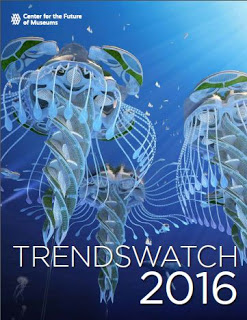
TrendsWatch 2016 is now up on the web! You can download your free PDF copy from the Alliance website. (Print copies will be available later this spring from the AAM Bookstore.)
Here are the chapters in this year’s report:
Labor 3.0: new jobs, or a jobless future?
More Than Human: extending the spectrum of ability
Me/We/Here/There: museums and the matrix of place-based augmented devices
Capture the Flag: the struggle over representation and identity
Happiness: because you get what you measure
This is the fifth edition of TrendsWatch, and it was the most difficult one to write so far. As I struggled over the draft I realized that for the first time the report has a unifying theme, even if it’s one that’s not easy to state. The topics that emerged from my scanning last year—the stories featured in CFM’s free weekly e-newsletter Dispatches from the Future of Museums, yet more stories I bookmarked in Diigo, sessions at the annual meeting, buzz at conferences—all revolve in some way around identity. What defines who I am? How does society impose identity on me (or you), and who controls how that identity is portrayed? How do I experience the world and empathize what it’s like for other people? What is the basic meaning of being human? How have we mischaracterized that in the past, and will it change in the future? Existential stuff for a futurist, but grounded in an examination of five tangible trends.
I open the report with a chapter on the future of labor—a broad look at all the ways that work and the workplace are changing. I’ve been told that one defining difference between cultures is whether and when you ask a stranger, “What do you do?” In the US (certainly in Washington DC, where I am based) that question is a conversation starter—what you do is seen as integral to who you are. Stay-at-home moms have long struggled to answer in a way that rejects our culture’s devaluation of unpaid labor—however much it contributes to our collective wellbeing. And wellbeing (in the form of happiness) anchors the report at the other end. Are jobs (and salary) really the most important things in the world? And if happiness is more important than money, shouldn’t that be how we define and measure success?
 |
| AAM Accreditation program officer Travis Kirspel let me borrow Della to test the proposition “Happiness is a Warm Puppy” |
Happiness starts with understanding and accepting oneself, but it’s a lot easier to be happy if other people accept you as you are, too. That being so, we are laying the groundwork for a happier future by starting to question the boxes we force people into. Even more fundamentally, we are beginning to question the reality of boxes themselves. A lot of attributes we have long treated as clearly bounded categories—race, gender, sexual orientation—are actually continuums. Chapter four of the report maps some of the implications of recognizing the blurriness of boundaries: How do we create buildings, communities and systems that accept that people fall along broad spectrums in all sorts of ways?
Accepting others as they are requires empathy, which is all too often in short supply. Therefore I’m encouraged to learn that some of the hottest emerging technologies—those of augmented and virtual realities—are described as “empathy machines” capable of helping people feel they literally are walking a mile in another’s shoes. I review some of the latest developments in AR and VR in chapter three.
Maybe with a little more AR/VR-enhanced understanding of what it’s like to be the“other,” we wouldn’t have designed so much of our environment to work for the “average” person. But we did, and now we are confronting society’s role in the creation of disability through our architecture and our behavior. As we celebrate the 25th anniversary of the Americans with Disabilities Act, we are rapidly improving our ability to not only compensate for disability, but correct for it. However, that acceleration only highlights the question: Who gets to say that certain ways of being human ought to be “fixed”? A growing number of disability rights movements are celebrating their distinct identities—and rejecting such fixes. And with the development of evermore sophisticated technologies that can augment our sensory, physical and cognitive capabilities, we are entering a future in which we can not only compensate for disabilities, but give people the choice of being “superabled.” How will such augmentation disrupt our traditional hierarchies of ability and (to loop back to chapter one) reshape labor?
Hand-in-hand with the question of identity goes the question of representation. Who gets to control the story of individuals and groups? As with disability/ability, this conversation is also about deconstructing traditional power structures—even though it’s unclear what the new structures will be. People are demanding to see themselves in their public institutions, but those institutions are besieged by competing claims. Who has standing to speak on behalf of a community? Given our increased recognition of the complexity of identity, who gets to say who does or does not even belong to a given group? Objects, as powerful symbols representing people and culture and history, are at the center of this struggle. And that means museums, as caretakers and interpreters of objects, are deeply enmeshed as well.
So—identity, representation, control, the deconstruction of categories, revisiting who we are and who we want to be. I told you it’s a complicated theme: big and messy and important. More than once as I started yet another round of revisions (with much input from my wonderful commenters), I doubted my qualifications to tackle these issues at all. But I decided these topics are too important to give them a pass. Knowing how widely TrendsWatchis used with museum staff, boards and museum studies programs, I feel obligated to put precisely these hard, important questions on the table. Where I get it wrong, I am sure that you, or others, will get it right. And I look forward to hearing what you have to say.
To that end, throughout the coming year Sylvea and I will be soliciting guest posts for the CFM Blog that illustrate how museums are navigating these trends. Indeed, we’ve already begun, by hosting essays by a number of the folk I talked to as this edition took shape. For example, in past few months:
- Ruth Quinn blogged about the Happy Museum Project, which challenges museums to use their position in society to promote well-being, sustainability and resilience,
- Alistair Brown of the Museums Association provided an update on museum labor issues in the UK, including the living wage movement,
- Daniel Vivien talked about the movement in Kentucky calling for the removal of a statue of Confederate President Jefferson Davis from the rotunda of the state capitol,
- Peder Nelson and Geoff Nunn shared the Museum of Flight’s forays into Virtual Reality
So, if you have a story to share about how these trends are playing out in your museum and your community, I encourage you to email Sylvea with your idea for a post (you can find the guestpost guidelines here).
Finally, please join me in thanking the donors and sponsors who make it possible for AAM to create and distribute this report as a free digital publication. TrendsWatch 2015 was downloaded over 4700 times—that kind of reach helps build a communal dialog in the field on important issues. Our lead sponsors this year are Aon, Blackbaud, Huntington T. Block, PGAV Destinations and Shultz & Williams. Additional support was provided by Amy Bartow-Melia and Greg Melia, Mary Case @ Qm2, History Associates, Inc. and Lisa Yun Lee. Also pitching in: Deirdre Araujo, Christine Bean, Peter Bishop, Barbara George, Eileen G. Goldspiel, Benjamin Gonzales, Eugene Kuo, Jane MacKnight, Jessica Marten, Patricia Rodewald, Philip Santore, Chris Siefert, Chris Wohlwill, and at least one person who would like to remain anonymous (you know who you are!) If you would like to contribute to our next effort, your contribution of any size would be much appreciated. There is a section on the TrendsWatch 2016 download page where you can make a gift.
Now—go, download, read, share, cogitate, comment…and think how you will navigate these trends in a way that will build a better future for your museum and your community.
Yours from the future,
Elizabeth








